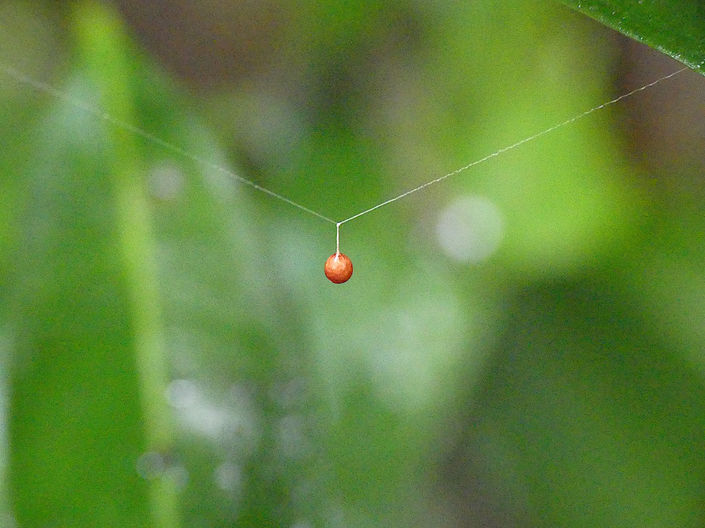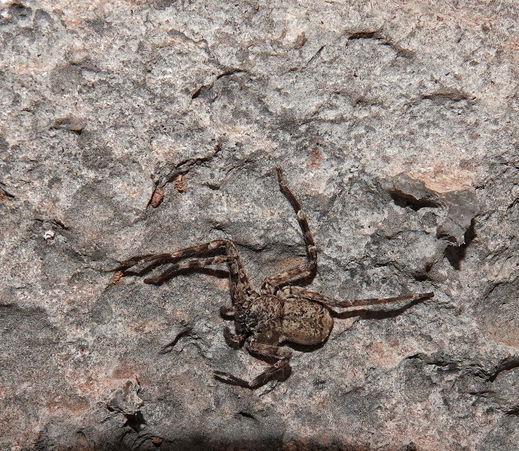Spiders
Family: Araneidae (Orbweavers)
(Order: Araneae; Suborder: Araenomorphae; Infraorder: Entelegynae; S.F: Araneoidea)
(Also called as Wheel spiders. These are ecribellate spiders with 8 eyes. The four median eyes are situated close to one another in a trapezoid and the lateral eyes are adjacent to each other. They usually build a vertical orb web)

Subfamily: Araneinae (Typical Orbweavers)
(They are the most common group of builders of spiral wheel-shaped webs often found in gardens, fields, and forests. The English word "orb" can mean "circular" hence the name of the group)
Below are several genus of Araenidae

Here are some Araneidae with proper identifications

Micrathena mitrata
White Micrathena
The web is often constructed in the understory of the woodlands. The male opisthosoma lacks the cat's face points.
TN
The opisthosoma is widest at the posterior end and tapers in a triangular shape which gives it the common name "arrow shaped"
TN


Verrucosa arenata
Triangulate Orbweaver
Unlike most spiders that sit in their webs with their head facing downward, this species sits in the web with its head facing up.
TN
Larinioides sclopetarius
Grey Cross Spiders
These are found especially on bridges and so they are also called as bridge orbweavers.
Stockholm





Gasteracantha geminata
Oriental Spiny Orb-Weaver
They constructs vertical orb webs, normally within open spaces between the branches of tall shrubs and thorns.
TN
Macracantha arcuata
Long-horned Orbweaver
One of the functions of this orb-weaver spider’s unusual giant stiff horns is probably to escape predators (such as birds and lizards) will have a very hard time trying to swallow it.
AS






Agalenatea redii
Gorse Orbweavers
The species is found in heather and gorse, usually below one metre above the ground, and in rough grasslands.
Crete
Argiope lobata
Lobed Argiope
The silver abdomen is marked deep furrows and distinctive lobes around the edge
HaDarom




Neoscona subfusca
Common Hairy Field Spider
Found mostly in trees and shrubs in warm, dry areas
Crete
Argiope trifasciata
Banded Garden Spider
Found mostly in trees and shrubs in warm, dry areas
Midresha


Gasteracantha kuhli
Black-and-white Spiny Spider
This species builds orb webs in open forests and shrubby areas and waits for prey in the center of the web.
KA




Gasteracantha dalyi
Jewel Spiny Spider
The genus name "Gasteracantha" is a combination of the Greek words γαστήρ which means belly and άκανθα which means thorns.
KA

Argiope aemula
Oval Saint Andrew's Cross Spider
In most cases, males are cannibalized when or after they insert their palpal bulb. If males are not cannibalized during the first insertion, they are almost guaranteed to get eaten after the second insertion.
TN



Argiope catenulata
Grass Cross Spider
They are common in all rice environments. They are late colonizers of rice fields.
TN

Argiope anasuja
Signature Spider
Male spins a web around the female's web, which is known as a companion web. Female lay eggs on the companion web and wrap them up into a sac. Spiderlings eat each other in the sac until the strongest spiderling break the sac wall
TN




Argiope aurantia
Yellow garden spider
Yellow garden spiders often build webs in areas adjacent to open sunny fields where they stay concealed and protected from the wind.
TN



Neoscona arabesca
Arabesque Orbweaver
Often called the arabesque orbweaver, after the cryptic, brightly colored, swirling markings on its prominent abdomen
TN
Family: Linyphiidae (Sheetweb and Dwarf Weavers )
(Order: Araneae; Suborder: Araenomorphae; Infraorder: Entelegynae; S.F: Araneoidea)
(They are carnivorous, eating flies and other soft bodied insects. They occur more in agricultural ecosystems, wetland and peatland areas)
Family: Nephilidae (Golden Orbweavers)
(Order: Araneae; Suborder: Araenomorphae; Infraorder: Entelegynae; S.F: Araneoidea)
Nephila spiders produce large asymmetric orb webs. They remain in their webs permanently, so have a higher predation risk. Nephila spiders display large sexual dimorphism in size, with females being greatly larger than males. Debate exists as to whether this is a result of male dwarfism or female gigantism.

Family: Tetragnathidae (Long-jawed Orbweavers)
(Order: Araneae; Suborder: Araenomorphae; Infraorder: Entelegynae; S.F: Araneoidea)
They have elongated bodies, legs, and chelicerae, and build small orb webs with an open hub with few, wide-set radii and spirals with no signal line or retreat. Some species are often found in long vegetation near water
Genus: Tetragnatha & Leucuage
Tetragnatha: are commonly called stretch spiders in reference to their elongated body form and their ability to hide on blades of grass or similar elongated substrates by stretching their front legs forward and the others behind them. The name Tetragnatha is derived from Greek, tetra- a numerical prefix referring to four and gnatha meaning "jaw"
Leucuage: They have two rows of long, slender curved hairs on the femurs of the fourth leg. In most cases the web is slanted rather than vertical and the spider rests in the middle of the web with its underside facing upwards.

TN USA

TN USA

KL, India

TN USA

TN USA

Suva, Fiji

KL, India

TN USA

Leucauge decorata
Decorative Silver Orb Spider
This species has a "point" to the end of the abdomen.
TN
Leucauge dromedaria
Silver Orb Spider
This species has a second pair of "humps" on the abdomen.
SY


Orange-and-black Pear Spider

KL India

KL India

Orange-and-black Pear Spider
Leucauge fastigata
Orange-and-black Pear Spider
In addition to the two rows of curved hairs (characteristic of Leucauge), they also have a thick brush of spines which are not present in most other species of Leucauge.
KA
Family: Theridiidae (Cobweb Spiders)
(Order: Araneae; Suborder: Araenomorphae; Infraorder: Entelegynae; S.F: Araneoidea)
These spiders are the ones that are responsible for making cobwebs. They make large messy sticky sheet webs attached to the ground. Most of the time these spiders can be found hanging upside down in the middle of the web. Some species from this family can actually be found on other species webs or and may feed on them or their eggs.
Super Family: Eresoidea (Eresidae & Hersiliidae)
(Order: Araneae; Suborder: Araenomorphae; Infraorder: Entelegynae)
Eresidae: This family can sometimes be confused with the jumping spiders, or those in the Palpimanidae family. These spiders are usually black or brown in colour, though they can also have brighter colours. As their common name implies they can look quite smooth and velvety. They usually live in silken tubes under objects, or underground.
Hersiliidae : They have two prominent spinnerets that are almost as long as their abdomen, earning them the nickname "two-tailed spiders". Rather than using a web that captures prey directly, they lay a light coating of threads over an area of tree bark and wait for an insect to stray onto the patch. When this happens, they encircle their spinnerets around their prey while casting silk on it. When the insect is immobilized, they can bite it through the shroud.

Families: Corinnidae, Palpimanidae & Selenopidae)
(Order: Araneae; Suborder: Araenomorphae; Infraorder: Entelegynae)
Corinnidae: formerly belonged to the Clubionidae, but are now considered a separate family. The spiders are very fast with long thin legs. They occur on leaves or bark of trees and hunt in the open and on tree trunks. A number of species are ant mimics and move as such.
Palpimanidae: They generally keep their very strong first legs held up in front of themselves while walking slowly at night, and on encountering possible prey they may feel it gently before grabbing it very rapidly and powerfully.
Selenopidae: are commonly referred to as wall crab spiders or "flatties" because of their dorsally flattened bodies. This family is named after the Greek moon goddess, Selene, due to the moon-like appearance of the eyes.
Family: Uloboridae (Hackled Orb Weavers)
(Order: Araneae; Suborder: Araenomorphae; Infraorder: Entelegynae)
Uloboridae is a family of non-venomous spiders, known as cribellate orb weavers. Their lack of venom glands is a secondarily evolved trait. Instead, they wrap their prey thoroughly in silk, cover it in regurgitated digestive enzymes, and then ingest the liquified body.
Super Family: Lycosoidea (Wolf Spiders and Allies)
(Order: Araneae; Suborder: Araenomorphae; Infraorder: Entelegynae)
Family: Lycosidae
(Order: Araneae; Suborder: Araenomorphae; Infraorder: Entelegynae)
Wolf spiders (from Ancient Greek λύκος (lúkos) 'wolf'). They are robust and agile hunters with excellent eyesight. They live mostly in solitude, hunt alone. Some are opportunistic hunters, pouncing upon prey as they find it or chasing it over short distances; others wait for passing prey in or near the mouth of a burrow.
Few members of Lycosidae:

Family: Oxyopidae:

Family: Pisauridae
These spiders are known for the way they carry their egg sac between a silk thread from their spinnerets and their chelicerae and how they create nursery webs for their spiderlings to hatch in. Some members of this family are semi-aquatic and have been known to hunt water insects and even small fish.

Family: Salticidae
This family contains over 600 described genera and over 6,000 described species making it the largest family of spiders at 13% of all species. Jumping spiders have some of the best vision among arthropods and use it in courtship, hunting, and navigation.

Family: Thomisidae
Members of this family of spiders do not spin webs, and are ambush predators. The two front legs are usually longer and more robust than the rest of the legs. The back two legs are smaller, and are usually covered in a series of strong spines

Family: Sparassidae
Huntsman spiders, members of this family (formerly Heteropodidae), are known by this name because of their speed and mode of hunting. They are also called giant crab spiders because of their size and appearance. Larger species sometimes are referred to as wood spiders, because of their preference for woody places (forests, mine shafts, woodpiles and wooden shacks).












































































































































































































